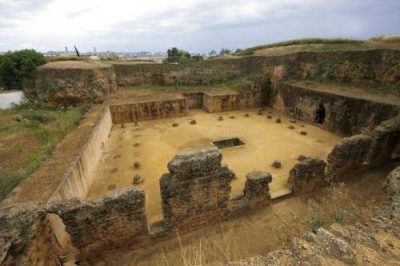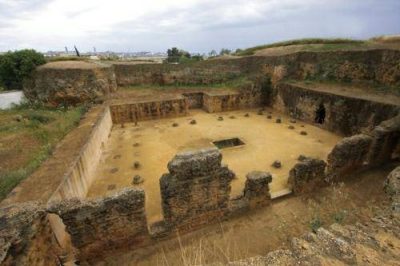The Roman necropolis was discovered and excavated at the end of the 19th century thanks to Juan Fernández López and the archaeologist, Jorge Bonsor’s initiative. It was used between the 1st and 2nd centuries of our era. The Necropolis dates back to the 1st century. The most common burial ritual was cremation. The bodies were cremated in burners excavated in the rock where the pyre was placed. Sometimes these burners were also used as burials, placing ashes in the pit, which were covered with ashlar, bricks or tiles. Once covered with earth, a stele would be placed to indicate the place and name of the deceased. The most common burial in the Necropolis of Carmona is an underground chamber, where several members of one family would be buried in a mausoleum. It was accessed through a staggered well. The chamber was commonly quadrangular in shape, with a bench that went around the lower part of the walls, where offerings would be placed and over which the niches were opened. In some of the chambers there are traces of the doors that closed them, whereas others would have been closed using a large slab. The external part of the burials, would have had memorial stones, stelae or tumuli and other constructions of which there are no remains. Tombs were decorated to hide the roughness of the rock. The Necropolis is one of the most important settlements in Spain because it holds a large number of paintings. The following are unmissable: *Tumba del Elefante* Elephant’s tomb – A sanctuary dedicated to the devotion of the deities Cybele and Attis. The worshiping of these Western gods reached great importance in Rome. Attis, a god that died and resuscitated every year was deep-rooted among locals, as other findings in the Necropolis show. It meant they somehow regained their own type of religion, typical of western and Mediterranean cultures, with which Carmona held unforgettable relationships for a great period of time. Alongside this god, was Mother Goddess, divine incarnation of nature, lady of life and death represented by an anionic shape of a Baetylus (ovoid stone). However, the figure of the elephant caused fascination since it was discovered, which became the most noteworthy symbol of eternity in this building. *Tumba de Servilia* Servilia’s tomb is the most monumental of the traditional structures represented in the Necropolis. Dating back to Augustus’s era, it keeps within Hellenistic models and reproduces a luxurious mansion with a wide porticoed patio, which opens out onto different rooms. One of these areas comprises a covered gallery. In its central section there is a chamber where it seems the Servilia sculpture was originally. In the front section of the porticoed patio, there is a funerary chamber, which has a large vestibule, with a trapezoid floor plan, covered by a pointed barrel vault; this provides it with a unique unprecedented character. In brief, everything makes us believe that the tomb, dating to Augustus’s era, must have belonged to a powerful family. The grandiosity of this tomb makes us think that Servilia, whose name we know thanks to the (unfortunately decapitated) statue found within it, must have belonged to a powerful family of Roman rulers. There is a complete museum at the Necropolis, with a large quantity of glass, clay, jewels, pieces related to funerary worship, as well as statues and reproductions of the paintings that decorated some of the tombs.
Address
Address:
necrópolis romana carmona
GPS:
37.469216913598, -5.6507501450137










